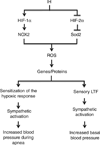Peripheral chemoreception and arterial pressure responses to intermittent hypoxia
- PMID: 25880505
- PMCID: PMC4423746
- DOI: 10.1002/cphy.c140039
Peripheral chemoreception and arterial pressure responses to intermittent hypoxia
Abstract
Carotid bodies are the principal peripheral chemoreceptors for detecting changes in arterial blood oxygen levels, and the resulting chemoreflex is a potent regulator of blood pressure. Recurrent apnea with intermittent hypoxia (IH) is a major clinical problem in adult humans and infants born preterm. Adult patients with recurrent apnea exhibit heightened sympathetic nerve activity and hypertension. Adults born preterm are predisposed to early onset of hypertension. Available evidence suggests that carotid body chemoreflex contributes to hypertension caused by IH in both adults and neonates. Experimental models of IH provided important insights into cellular and molecular mechanisms underlying carotid body chemoreflex-mediated hypertension. This article provides a comprehensive appraisal of how IH affects carotid body function, underlying cellular, molecular, and epigenetic mechanisms, and the contribution of chemoreflex to the hypertension.
© 2015 American Physiological Society.
Figures





References
-
- Abu-Shaweesh JM, Martin RJ. Neonatal apnea: What’s new? Pediatr Pulmonol. 2008;43:937–944. - PubMed
-
- Ambrosio G, Zweier JL, Duilio C, Kuppusamy P, Santoro G, Elia PP, Tritto I, Cirillo P, Condorelli M, Chiariello M. Evidence that mitochondrial respiration is a source of potentially toxic oxygen free radicals in intact rabbit hearts subjected to ischemia and reflow. J Biol Chem. 1993;268:18532–18541. - PubMed
-
- Banfi B, Maturana A, Jaconi S, Arnaudeau S, Laforge T, Sinha B, Ligeti E, Demaurex N, Krause KH. A mammalian H+ channel generated through alternative splicing of the NADPH oxidase homolog NOH-1. Science. 2000;287:138–142. - PubMed
Publication types
MeSH terms
Substances
Grants and funding
LinkOut - more resources
Full Text Sources
Other Literature Sources
Medical

